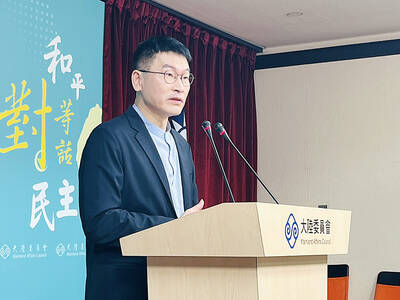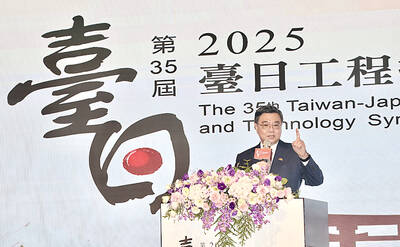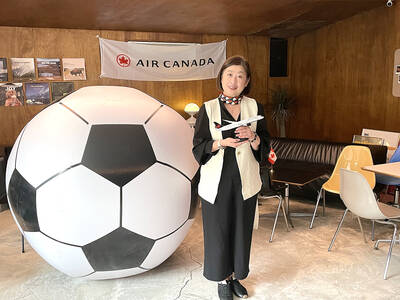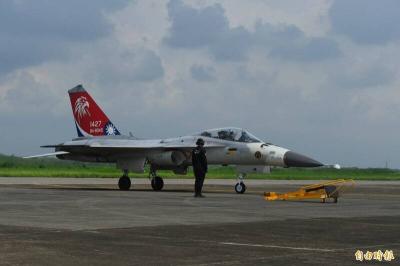The Ministry of Education on Wednesday unveiled guidelines for teaching English, aiming to have 60 percent of schools use English as a the sole medium of instruction for the language by 2024.
Minister of Education Pan Wen-chung (潘文忠) said the ministry has intensified its efforts to train Taiwanese teachers of English and recruit foreign teachers of English to attain the nation’s goal of becoming a Mandarin-English bilingual country.
With a growing pool of English teachers, Pan said the 2021-2022 school year would become an important beginning for teaching the language.
The aim is to have teachers in 60 percent of elementary, junior and senior-high schools use only English to teach the language by 2024, he said.
English would also be used to teach other courses to improve students’ proficiency, he said, adding that by 2024, teachers in one-seventh of schools would be asked to teach courses in English.
Afterward, teachers in all schools would be asked to use English only to teach English classes by 2030, he said.
He added that teachers in one-third of schools would be asked to teach part of their courses besides English classes in a bilingual manner, also by 2030.
Pan said that high schools are a critical link to higher education, so the ministry is planning to have 50 high schools offer bilingual classes on a trial basis starting this school year.
Schools should make good use of the budget provided to run their bilingual classes this year, he said, adding that the bilingual classes would eventually be expanded to other schools.
Also, starting this school year, the ministry would launch a large-scale campaign to recruit foreign English teachers, he said.
As part of the recruitment effort, the ministry would have National Taiwan Normal University (NTNU) and National Chung Cheng University set up counseling centers to provide assistance to foreign teachers, he said.
To help persuade foreign teachers to stay in Taiwan, the ministry would provide subsidies for their living expenses, including lodging and transportation, he added.
Earlier this year, the ministry said it would make National Taiwan University, NTNU, National Cheng Kung University and National Sun Yat-sen University as priority schools for bilingual teaching.
Making Taiwan bilingual by 2030 is a policy initiated by Vice President William Lai (賴清德) in 2018 when he was premier. In June that year, Lai made the “2030 Bilingual Country” plan a major national policy.
On Thursday last week, the Executive Yuan approved a draft bill to establish a national development center to advance the plan to develop Taiwan into a bilingual Chinese and English-speaking nation by 2030.

LOW RISK: Most nations do not extradite people accused of political crimes, and the UN says extradition can only happen if the act is a crime in both countries, an official said China yesterday issued wanted notices for two Taiwanese influencers, accusing them of committing “separatist acts” by criticizing Beijing, amid broadening concerns over China’s state-directed transnational repression. The Quanzhou Public Security Bureau in a notice posted online said police are offering a reward of up to 25,000 yuan (US$3,523) for information that could contribute to the investigation or apprehension of pro-Taiwanese independence YouTuber Wen Tzu-yu (溫子渝),who is known as Pa Chiung (八炯) online, and rapper Chen Po-yuan (陳柏源). Wen and Chen are suspected of spreading content that supported secession from China, slandered Chinese policies that benefit Taiwanese and discrimination against Chinese spouses of

ALIGNED THINKING: Taiwan and Japan have a mutual interest in trade, culture and engineering, and can work together for stability, Cho Jung-tai said Taiwan and Japan are two like-minded countries willing to work together to form a “safety barrier” in the Indo-Pacific region, Premier Cho Jung-tai (卓榮泰) yesterday said at the opening ceremony of the 35th Taiwan-Japan Modern Engineering and Technology Symposium in Taipei. Taiwan and Japan are close geographically and closer emotionally, he added. Citing the overflowing of a barrier lake in the Mataian River (馬太鞍溪) in September, Cho said the submersible water level sensors given by Japan during the disaster helped Taiwan monitor the lake’s water levels more accurately. Japan also provided a lot of vaccines early in the outbreak of the COVID-19 pandemic,

PROMOTION: Travelers who want a free stopover must book their flights with designated travel agents, such as Lion Travel, Holiday Tours, Cola Tour and Life Tours Air Canada yesterday said it is offering Taiwanese travelers who are headed to North America free stopovers if they transit though airports in Japan and South Korea. The promotion was launched in response to a potential rise in demand for flights to North America in June and July next year, when the US, Canada and Mexico are scheduled to jointly host the FIFA World Cup, Air Canada said. Air Canada offers services to 13 of the 16 host cities of the tournament’s soccer games, including Toronto and Vancouver; Mexico City, Guadalajara and Monterrey in Mexico; Atlanta, Georgia; Boston; Dallas; Houston;

The US approved the possible sale to Taiwan of fighter jet spare and repair parts for US$330 million, the Pentagon said late yesterday, marking the first such potential transaction since US President Donald Trump took office in January. "The proposed sale will improve the recipient's capability to meet current and future threats by maintaining the operational readiness of the recipient's fleet of F-16, C-130," and other aircraft, the Pentagon said in a statement. Trump previously said that Chinese President Xi Jinping (習近平) has told him he would not invade Taiwan while the Republican leader is in office. The announcement of the possible arms